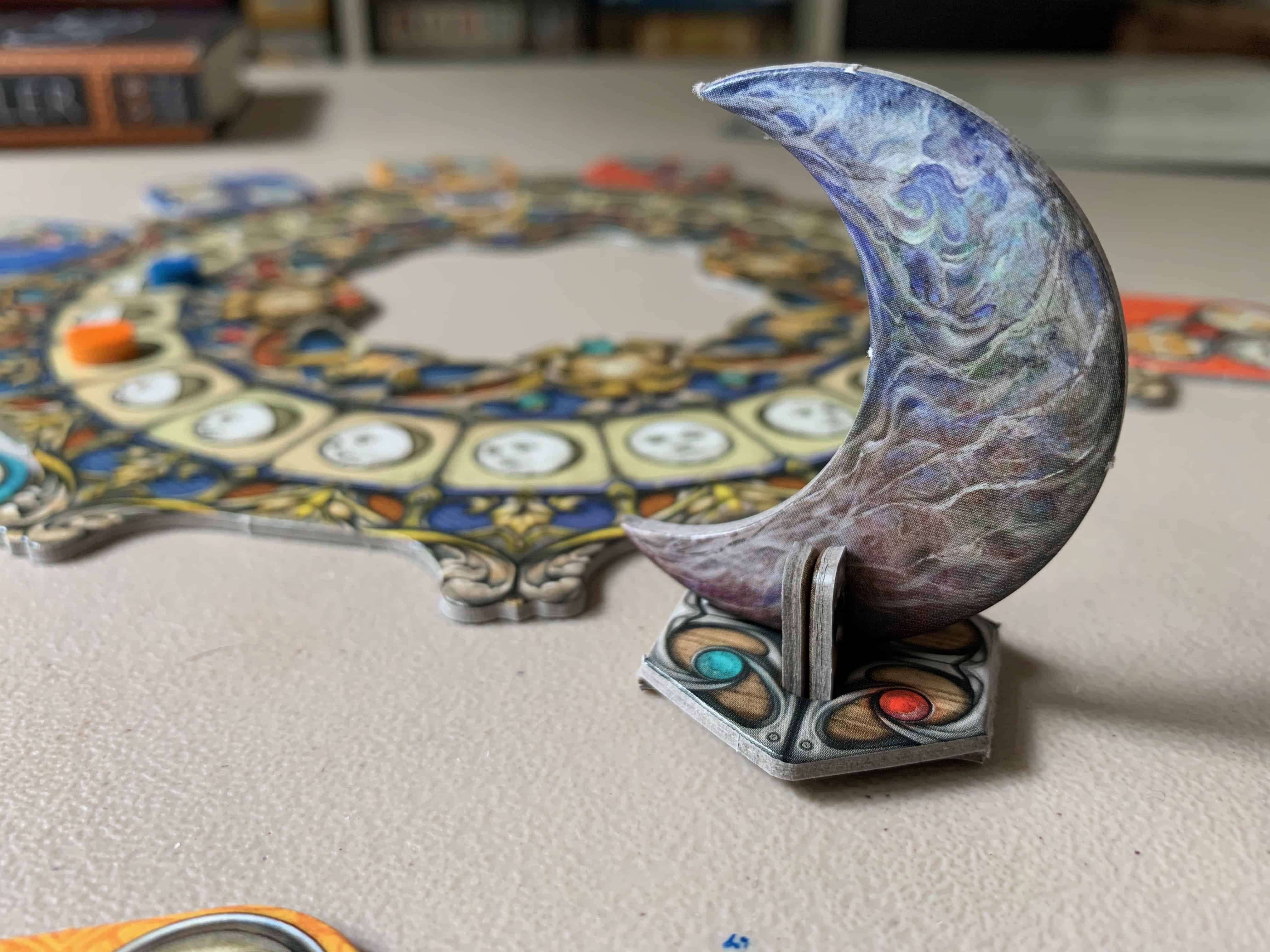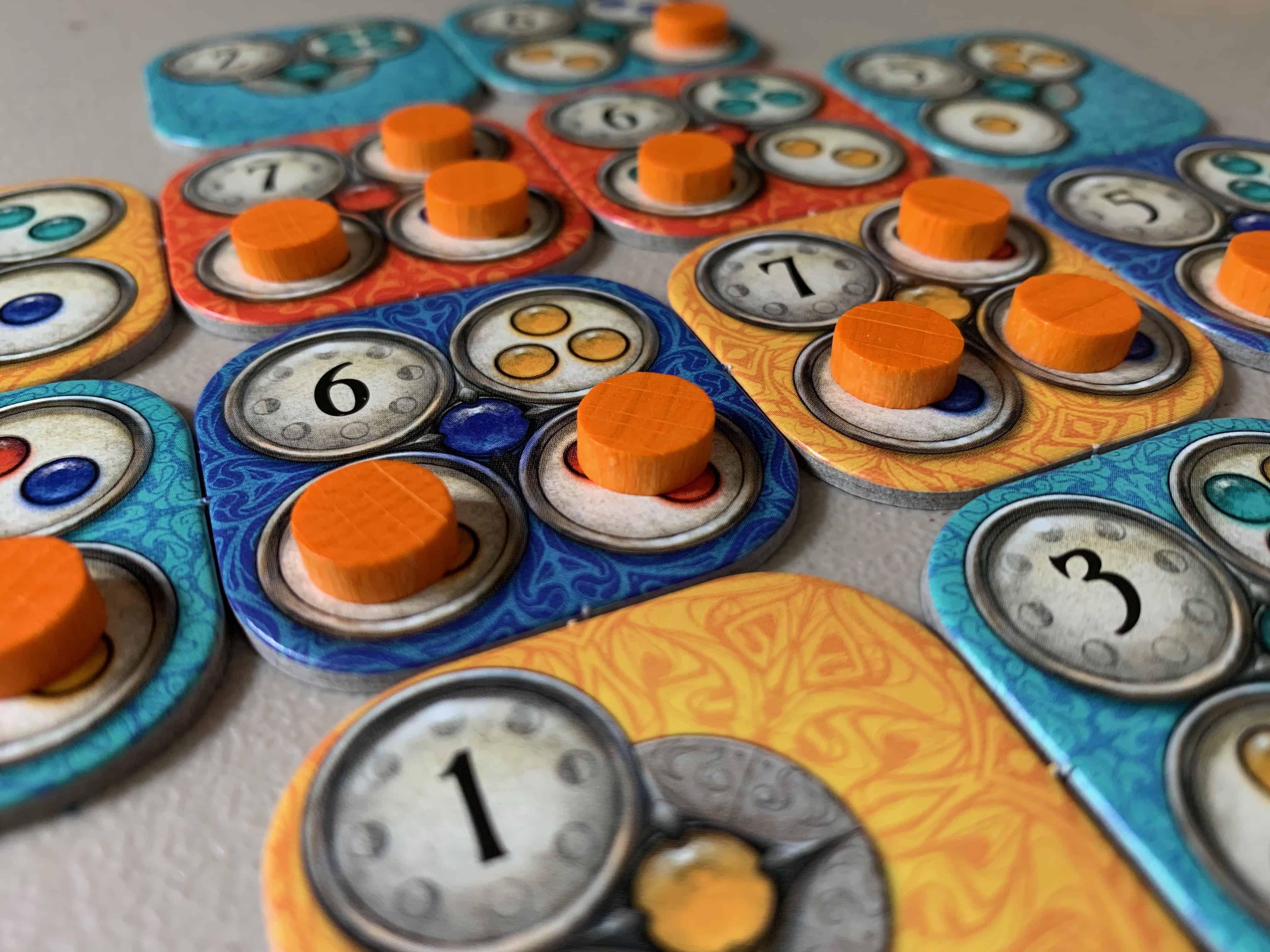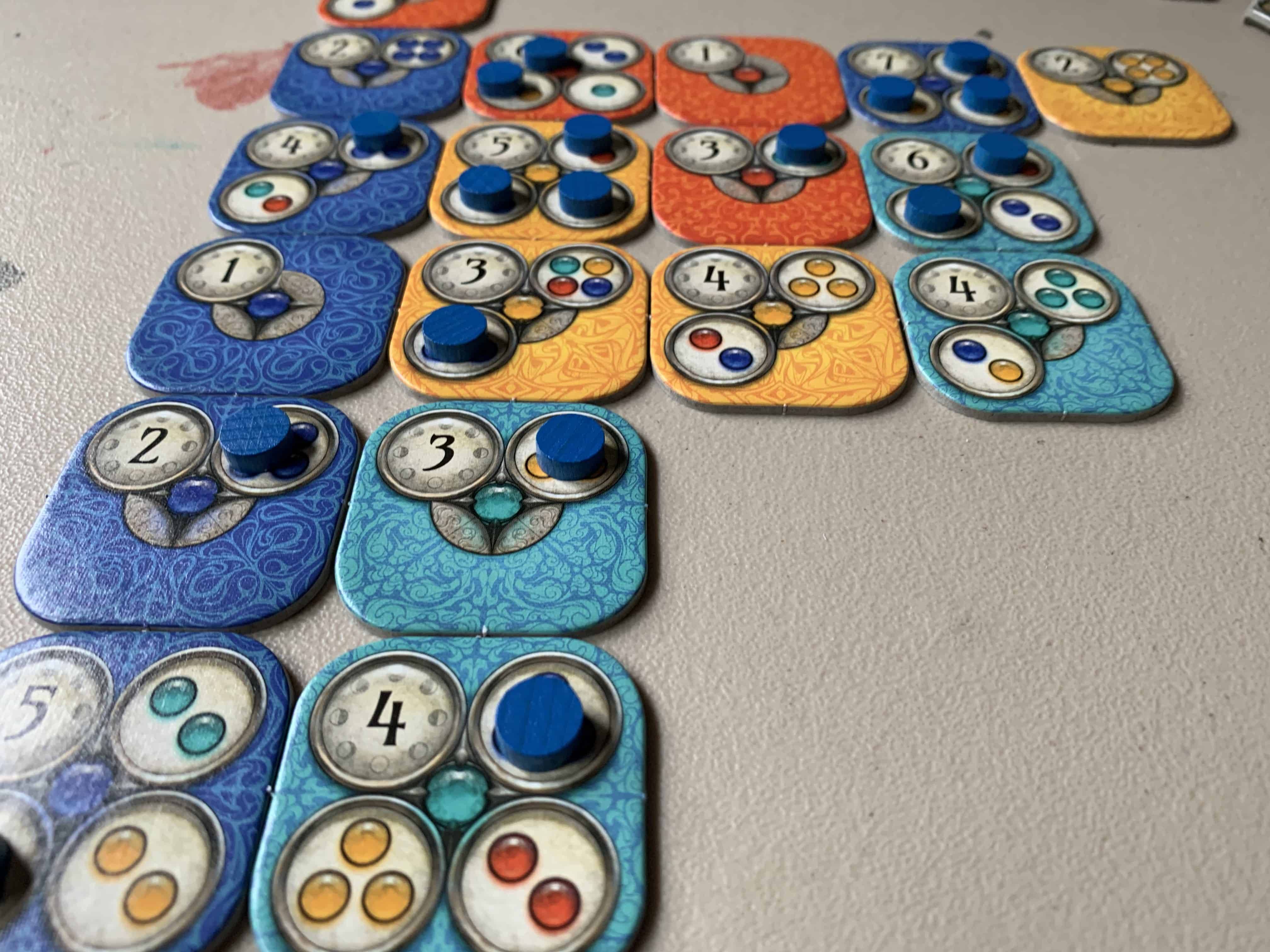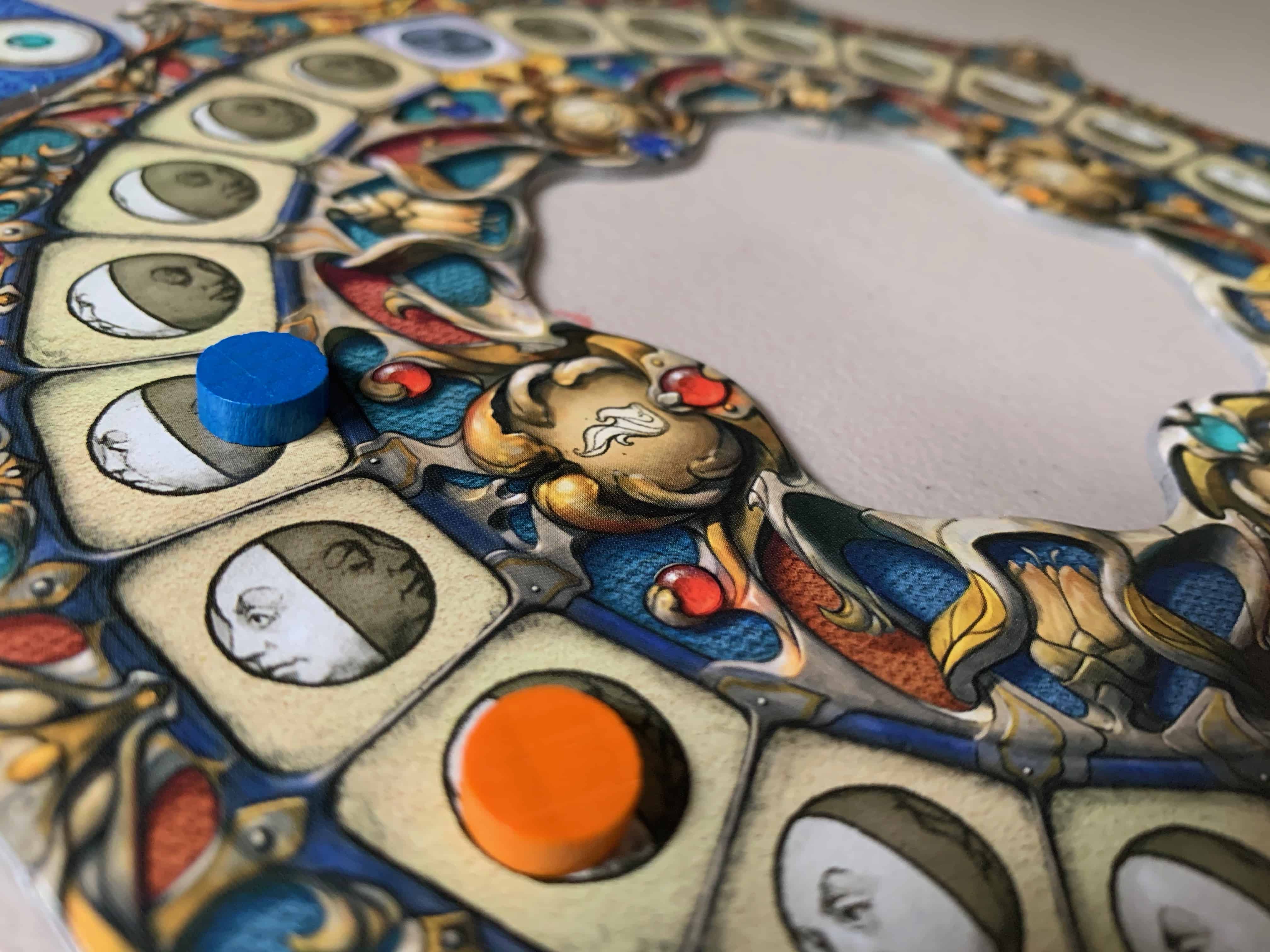Uwe Rosenberg, the worker placement genius. A man so synonymous with the genre, that his name became an adjective to describe it. Shorthand for a sandbox of choices. But something changed.
While working on his magnum opus, the brilliant and sweeping A Feast for Odin, Rosenberg discovered the puzzle genre. His first release with the mechanic – Patchwork – was a smash hit, a go-to two-player game for gamers of all ages. But he didn’t stop there. His puzzle trilogy asked players to piece together polyominos in gardens, along forest paths, and in a spring meadow.
So it’s no surprise that nearly four years since A Feast for Odin released, Rosenberg is still pulling from the puzzle well. What is surprising, though, is how effectively he has done so with his most recent release – Nova Luna.
How Nova Luna Plays
Nova Luna is not purely an Uwe Rosenberg game. You’ll see he is dual-credited on the cover alongside Corné van Moorsel whose 2016 game, Habitats, is the basis for his new game. Van Moorsel has been prolific over two decades of design, probably most successful with Factory Fun and Factory Funner, the latter of which was on Kickstarter just a few years ago.
But he’s been very much an under the radar designer, with Habitats being his most successful game – albeit somewhat middling in reviews. Nova Luna takes the core concept from that game, and combines it with a bit of Patchwork’s tile selection mechanisms and creates a beautiful, simple abstract game.
What is perhaps most astounding about Nova Luna, though, is that it does away with the victory point baseline that most Rosenberg games use. Instead, it is a race game – a clever spin on the “get rid of your discs” first mechanic.
The game features a striking board in the middle of the table, with spaces representing the phases of the moon. Around the board, you’ll place 11 tiles that feature an amount of time (familiar to those who have played Patchwork), 0-3 goals, and a color.

Players will move the moon marker around the moon board clockwise and draft these tiles into their tableaus, attempting to complete the goals as quickly as possible. Players can only choose between the three tiles on front of the moon marker, and can only refill the moon board with new tiles when there are 0-2 tiles left. This is all very similar to Patchwork, which is a fantastic mechanic and works well in a tighter, abstract-heavy game. Like in Patchwork, the player whose piece is further back always takes the next turn, so if someone gets overly aggressive and takes a 7, the other player could get 2-3 extra turns in a row.
The goal completion is equally elegant – eschewing complicated patterns and resource mechanics for a simple color matching system. A goal might look like this:

With 1-4 colored dots in a small circle. To achieve this goal, those colored tiles must be adjacent to that tile. You can chain these together, however. So if a tile needs three blue to complete a goal, you could have a string of three blue tiles adjacent to it in one of the cardinal directions. Diagonal, of course, does not count.

The goals don’t all need to be completed, but each time one is, the player places a disc on it, and the first player to place all their discs wins.
What We Like About Nova Luna
Nova Luna feels like a distilled version of Patchwork. The games are inherently different in many ways, but they fill a similar niche – a short, accessible puzzle game. And in the case of Nova Luna, it feels best at two players, though does support player counts between 1-4.
The game flows seamlessly, with few breaks and minimal AP. Players are encouraged to take tiles with lower numbers, but also need to find synergy between their tiles so they can complete goals quickly. The luck of the draw when refilling the moon board is another major component to watch. If you build a tableau that relies heavily on yellow tiles coming out and the draw features no yellow tiles, you are likely to fall behind waiting for the next refill, if it even comes.
This requires a tactical approach to the game similar to the best abstract strategy games, but not necessarily so devoid of a forward-thinking plan as to be dull.
The game is also something to look at. The illustrations are simple, but evocative of the visions of the moon drawn by cartoonists and filmmakers a hundred years ago, a Victorian-era approach colored by the 19th century’s rapid reliance on technology. There are no illustrations beyond the mainboard and the tiles are simple enough, but they don’t need to be – the gameplay does the talking here and it does it well.
What We Don’t Like About Nova Luna
Here’s where this game gets tricky. I have exactly two complaints about Nova Luna – both of which are common, but unfortunately are pulling down a game that more people should play.
This game was nominated for the Spiel des Jahre and rightfully so. It’s one of the best abstract strategy games I’ve played since Azul first launched. But it’s a steep price here in the US. Stronghold Games once again adds a premium to a new game, and this time I think it’s hurting. $50 for a single board and a couple of sheets of tiles is hard to stomach, even in this age of inflated game prices.
It’s a shame too because, at $30 or $35, this game would have exploded. It’s clever, it’s quick, it’s easy to teach and it’s accessible. It pulls off the Azul hat trick quite nicely. But as is, the game was under printed and overpriced, meaning few people have gotten their hands on it yet. An SdJ win may have overcome that, but as is, this one won’t have nearly the impact it could have as a result.
The second issue is much smaller. The solo game, while clever and a fun little puzzle is even more dependent on luck than the multiplayer game. In it, you are allowed to fill the board twice, meaning at most 22 tiles will come out. You have to use all 21 of your discs to complete goals before the 22nd tile is taken. You don’t lose if you can’t, but there is a score threshold of 100, adding together the time on the tiles and 10 extra time for every disc you didn’t place. It feels like you will win if you get all your discs out, but getting them all out can be a luck-based thing. Again, if you build for a color or two and they don’t come out in the second half, you’re in a bad place.
I still like it quite a bit, but it’s not going to light the solo gaming world on fire. Thankfully, it’s so sublime with 2 or more and decent enough at 1, that it doesn’t impact my feelings on the game much at all.
The Bottom Line
Nova Luna is a brilliant game, combining the mechanics from two great games to make one spectacular game that is well-deserving of its SdJ nomination and one I’ll gladly support if it wins. It’s light, it’s fast, and it’s accessible, but it offers depth for decision making that really stands out among similar games to release in recent years.
This game is a buy for me, especially if you can find it at a reasonable price online.
SUMMARY & RESULTS
8.0
Nova Luna is a streamlined, carefully constructed abstract game - the price is unfortunate, but the game is fantastic if you get a chance to play.





Show Comments